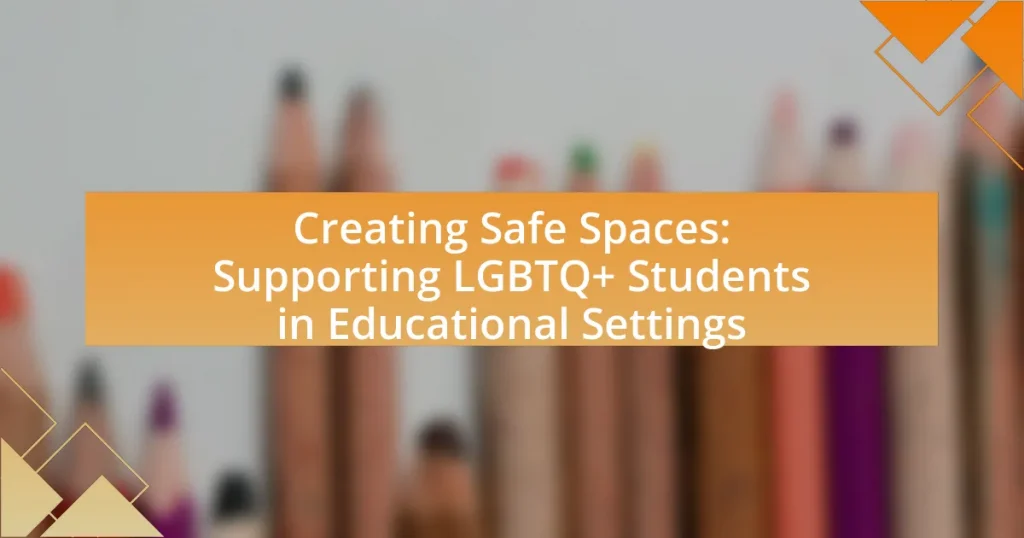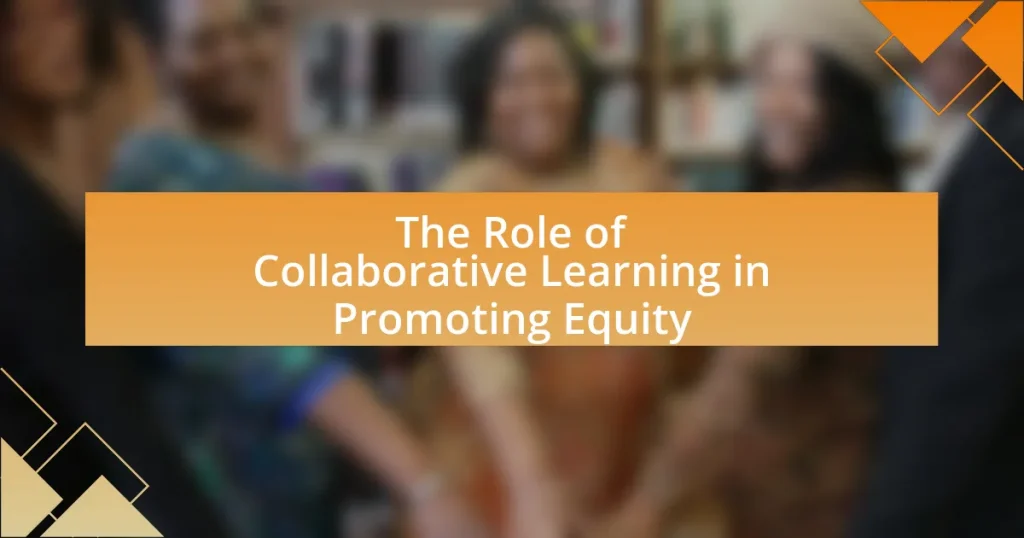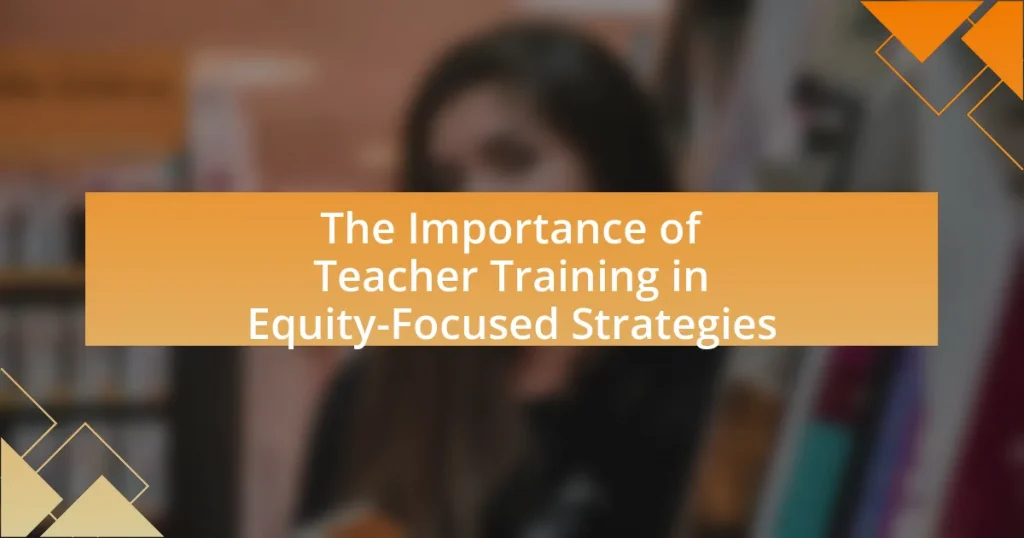The article focuses on the importance of creating safe spaces for LGBTQ+ students in educational settings, highlighting their role in fostering inclusivity, emotional support, and improved mental health outcomes. It discusses the characteristics that define safe spaces, the impact of peer support, and the necessity of inclusive policies and training for educators. Additionally, the article addresses the challenges LGBTQ+ students face, including bullying and discrimination, and outlines effective strategies for schools to promote awareness, acceptance, and community involvement in supporting these students. Overall, it emphasizes the critical need for supportive environments to enhance the well-being and academic success of LGBTQ+ youth.

What are Safe Spaces for LGBTQ+ Students?
Safe spaces for LGBTQ+ students are designated environments where individuals can express their identities without fear of discrimination or harassment. These spaces provide emotional support, foster inclusivity, and promote understanding among diverse student populations. Research indicates that safe spaces contribute to improved mental health outcomes for LGBTQ+ youth, reducing feelings of isolation and increasing academic engagement. For instance, a study published in the Journal of Youth and Adolescence found that students who participated in supportive environments reported higher levels of self-esteem and lower levels of depression.
Why are Safe Spaces important in educational settings?
Safe spaces are important in educational settings because they provide a supportive environment where students, particularly those from marginalized groups such as LGBTQ+ individuals, can express themselves without fear of discrimination or harassment. Research indicates that safe spaces contribute to improved mental health outcomes, increased academic performance, and a greater sense of belonging among students. For instance, a study published in the Journal of Educational Psychology found that students who felt safe and supported in their school environment reported higher levels of engagement and lower levels of anxiety. This underscores the critical role safe spaces play in fostering inclusivity and promoting the well-being of all students.
How do Safe Spaces impact the mental health of LGBTQ+ students?
Safe spaces significantly improve the mental health of LGBTQ+ students by providing a supportive environment where they can express their identities without fear of discrimination. Research indicates that LGBTQ+ students who have access to safe spaces report lower levels of anxiety and depression compared to those who do not. For instance, a study published in the Journal of Youth and Adolescence found that students in supportive environments experienced increased feelings of belonging and self-acceptance, which are crucial for mental well-being. Additionally, safe spaces facilitate peer support and community building, further enhancing emotional resilience among LGBTQ+ youth.
What role do Safe Spaces play in fostering inclusivity?
Safe Spaces play a crucial role in fostering inclusivity by providing environments where individuals, particularly those from marginalized groups, can express themselves without fear of discrimination or harassment. These designated areas promote open dialogue, support, and acceptance, which are essential for the emotional and psychological well-being of LGBTQ+ students. Research indicates that schools with Safe Spaces report higher levels of student engagement and lower rates of bullying, demonstrating that such environments contribute positively to the overall school climate. For instance, a study by GLSEN found that LGBTQ+ students who attended schools with supportive environments, including Safe Spaces, were 30% less likely to feel unsafe at school compared to those without such resources.
What characteristics define a Safe Space?
A Safe Space is characterized by inclusivity, respect, and support for individuals, particularly those from marginalized communities such as LGBTQ+ individuals. These spaces foster an environment where individuals feel free to express their identities without fear of discrimination or harassment. Research indicates that Safe Spaces promote emotional well-being and academic success among LGBTQ+ students by providing a supportive network and resources tailored to their needs. For instance, a study published in the Journal of LGBT Youth highlights that Safe Spaces significantly reduce feelings of isolation and increase engagement in educational settings.
How can educators create an environment that feels safe for LGBTQ+ students?
Educators can create a safe environment for LGBTQ+ students by implementing inclusive policies and practices that affirm their identities. This includes establishing anti-bullying policies that specifically address discrimination based on sexual orientation and gender identity, which research shows can significantly reduce harassment and improve the overall school climate. Additionally, educators should incorporate LGBTQ+ topics into the curriculum, providing representation and fostering understanding among all students. Training staff on LGBTQ+ issues and creating support systems, such as Gay-Straight Alliances, further enhances the sense of safety and belonging for LGBTQ+ students. Studies indicate that schools with supportive environments see higher academic performance and lower dropout rates among LGBTQ+ youth, demonstrating the effectiveness of these strategies.
What policies support the establishment of Safe Spaces?
Policies that support the establishment of Safe Spaces include anti-discrimination laws, inclusive curriculum mandates, and training programs for staff on LGBTQ+ issues. Anti-discrimination laws, such as Title IX in the United States, prohibit discrimination based on sex and gender identity, thereby creating a legal framework that protects LGBTQ+ students. Inclusive curriculum mandates require educational institutions to incorporate LGBTQ+ history and perspectives into their teaching, fostering an environment of acceptance and understanding. Additionally, training programs for educators equip staff with the knowledge and skills to support LGBTQ+ students effectively, promoting a culture of safety and respect within schools. These policies collectively contribute to the creation of Safe Spaces for LGBTQ+ students in educational settings.

How can educators support LGBTQ+ students effectively?
Educators can support LGBTQ+ students effectively by creating inclusive environments that affirm their identities and promote respect among peers. This can be achieved through implementing comprehensive anti-bullying policies, integrating LGBTQ+ topics into the curriculum, and providing access to supportive resources such as counseling services. Research indicates that schools with inclusive policies report lower rates of bullying and higher levels of student well-being, as evidenced by the 2019 National School Climate Survey, which found that LGBTQ+ students in supportive environments experience less harassment and greater academic success.
What training do educators need to create Safe Spaces?
Educators need training in cultural competency, inclusive practices, and trauma-informed approaches to create Safe Spaces for LGBTQ+ students. Cultural competency training equips educators with the knowledge to understand and respect diverse identities, while inclusive practices training focuses on implementing policies and curricula that affirm LGBTQ+ identities. Trauma-informed approaches help educators recognize and respond to the effects of trauma that LGBTQ+ students may experience, fostering a supportive environment. Research indicates that schools with trained staff in these areas report higher levels of student safety and well-being, as evidenced by studies from the Gay, Lesbian & Straight Education Network (GLSEN) which highlight the positive impact of such training on student experiences.
How can professional development enhance understanding of LGBTQ+ issues?
Professional development can enhance understanding of LGBTQ+ issues by providing educators with targeted training and resources that address the unique challenges faced by LGBTQ+ individuals. This training often includes workshops, seminars, and courses that cover topics such as inclusive teaching practices, the importance of representation, and the impact of discrimination on LGBTQ+ students. Research indicates that educators who participate in professional development focused on LGBTQ+ issues are more likely to create supportive environments, as evidenced by a study published in the Journal of LGBT Youth, which found that teachers who received such training reported increased confidence in addressing LGBTQ+ topics and improved student outcomes.
What resources are available for educators to learn about LGBTQ+ inclusivity?
Educators can access various resources to learn about LGBTQ+ inclusivity, including organizations, online courses, and literature. Notable organizations such as GLSEN (Gay, Lesbian & Straight Education Network) provide comprehensive resources, including lesson plans and training materials focused on creating inclusive environments. Online platforms like Coursera and edX offer courses specifically addressing LGBTQ+ issues in education, enabling educators to gain insights and strategies for fostering inclusivity. Additionally, literature such as “The Gender Revolution: A Guide for Educators” by Dr. J. Michael Bailey provides evidence-based approaches to understanding and supporting LGBTQ+ students. These resources collectively equip educators with the knowledge and tools necessary to create safe and supportive educational spaces for all students.
How can peer support contribute to Safe Spaces?
Peer support significantly contributes to Safe Spaces by fostering a sense of belonging and acceptance among LGBTQ+ students. This supportive environment encourages open communication, reduces feelings of isolation, and enhances emotional well-being. Research indicates that peer support networks can lead to improved mental health outcomes, as students who engage in these networks report lower levels of anxiety and depression. A study published in the Journal of Youth and Adolescence found that LGBTQ+ youth with strong peer support systems are more likely to feel safe and accepted in their educational settings, reinforcing the importance of peer relationships in creating inclusive Safe Spaces.
What role do student organizations play in supporting LGBTQ+ peers?
Student organizations play a crucial role in supporting LGBTQ+ peers by providing safe spaces for community building, advocacy, and resources. These organizations foster an inclusive environment where LGBTQ+ students can express their identities without fear of discrimination. For instance, research indicates that campuses with active LGBTQ+ student organizations report higher levels of acceptance and lower instances of bullying among LGBTQ+ individuals. Additionally, these organizations often host events, workshops, and discussions that educate the broader student body about LGBTQ+ issues, promoting awareness and understanding. This active engagement not only empowers LGBTQ+ students but also cultivates allyship among their peers, reinforcing a supportive campus culture.
How can allies effectively support LGBTQ+ students in educational settings?
Allies can effectively support LGBTQ+ students in educational settings by actively promoting inclusivity and advocating for policies that protect their rights. This includes implementing anti-bullying measures, creating LGBTQ+ inclusive curricula, and providing safe spaces where students can express their identities without fear of discrimination. Research indicates that schools with supportive environments see improved mental health outcomes for LGBTQ+ youth, as highlighted in the 2019 National School Climate Survey by GLSEN, which found that students who felt supported by staff were less likely to experience harassment and had higher academic performance.

What challenges do LGBTQ+ students face in educational settings?
LGBTQ+ students face significant challenges in educational settings, including bullying, discrimination, and lack of support from peers and faculty. Research indicates that approximately 70% of LGBTQ+ students experience harassment at school, which can lead to negative academic outcomes and mental health issues. Additionally, many educational institutions lack comprehensive policies to protect LGBTQ+ students, further exacerbating feelings of isolation and vulnerability. Studies show that supportive environments can improve the well-being and academic performance of these students, highlighting the need for effective interventions and inclusive practices in schools.
How does bullying affect LGBTQ+ students’ experiences in schools?
Bullying significantly negatively impacts LGBTQ+ students’ experiences in schools by leading to increased feelings of isolation, anxiety, and depression. Research indicates that LGBTQ+ students who experience bullying are more likely to report lower academic performance and higher dropout rates. For instance, a study by the Gay, Lesbian & Straight Education Network (GLSEN) found that 59.1% of LGBTQ+ students felt unsafe at school due to their sexual orientation, and 42.5% due to their gender expression. This hostile environment not only affects their mental health but also hinders their ability to engage fully in the educational experience, ultimately affecting their overall well-being and future opportunities.
What are the long-term effects of bullying on LGBTQ+ students?
The long-term effects of bullying on LGBTQ+ students include increased rates of mental health issues, such as depression and anxiety, as well as higher instances of suicidal ideation. Research indicates that LGBTQ+ youth who experience bullying are more likely to suffer from long-lasting psychological trauma, which can manifest in various ways, including substance abuse and difficulties in forming healthy relationships. A study published in the Journal of Adolescent Health found that LGBTQ+ students who faced bullying reported significantly higher levels of distress and lower self-esteem compared to their peers. Furthermore, the National School Climate Survey revealed that 60% of LGBTQ+ students felt unsafe at school due to their sexual orientation, leading to chronic absenteeism and disengagement from the educational environment. These statistics underscore the profound and enduring impact of bullying on the well-being and academic success of LGBTQ+ students.
How can schools address and prevent bullying of LGBTQ+ students?
Schools can address and prevent bullying of LGBTQ+ students by implementing comprehensive anti-bullying policies that specifically include protections for sexual orientation and gender identity. Research indicates that schools with inclusive policies experience lower rates of bullying and harassment; for example, the 2019 National School Climate Survey found that LGBTQ+ students in schools with supportive policies reported feeling safer and more accepted. Additionally, training staff on LGBTQ+ issues and promoting awareness through educational programs can foster an inclusive environment. The GLSEN (Gay, Lesbian & Straight Education Network) emphasizes that creating Gay-Straight Alliances (GSAs) and providing resources for LGBTQ+ students can significantly reduce instances of bullying and improve overall school climate.
What barriers exist in implementing Safe Spaces?
Barriers in implementing Safe Spaces include lack of institutional support, insufficient training for staff, and resistance from the community. Institutional support is crucial; without it, initiatives may lack funding and resources, as evidenced by a study from the Human Rights Campaign which found that schools with strong administrative backing are more likely to successfully implement Safe Spaces. Insufficient training for staff can lead to misunderstandings about LGBTQ+ issues, resulting in ineffective support; research by GLSEN indicates that educators who receive training are more confident in creating inclusive environments. Community resistance can manifest as pushback from parents or local organizations, which can hinder the establishment of Safe Spaces, as highlighted in surveys showing that schools facing community opposition struggle to maintain these supportive environments.
How can schools overcome resistance to creating Safe Spaces?
Schools can overcome resistance to creating Safe Spaces by actively engaging stakeholders through education and dialogue. By providing training sessions for teachers, parents, and students about the importance of Safe Spaces, schools can foster understanding and reduce misconceptions. Research indicates that inclusive environments improve student well-being and academic performance, as highlighted in the 2019 GLSEN National School Climate Survey, which found that LGBTQ+ students in supportive environments reported higher levels of safety and belonging. Additionally, schools can establish clear policies that promote inclusivity and protect against discrimination, thereby demonstrating a commitment to creating a safe environment for all students.
What misconceptions about LGBTQ+ students hinder support efforts?
Misconceptions about LGBTQ+ students that hinder support efforts include the belief that all LGBTQ+ students are openly identifying as such, the assumption that they do not face bullying or discrimination, and the idea that their needs are the same as those of heterosexual students. These misconceptions can lead to a lack of tailored support and resources. For instance, a study by the Gay, Lesbian & Straight Education Network (GLSEN) found that 59% of LGBTQ+ students felt unsafe at school due to their sexual orientation, indicating that the assumption of safety is unfounded. Additionally, the belief that LGBTQ+ issues are not relevant to all students ignores the broader impact of inclusivity on school culture, which can affect academic performance and mental health.
What best practices can schools adopt to create Safe Spaces?
Schools can adopt several best practices to create Safe Spaces for LGBTQ+ students, including implementing anti-bullying policies, providing training for staff on LGBTQ+ issues, and establishing support groups. Anti-bullying policies that specifically address discrimination based on sexual orientation and gender identity can significantly reduce harassment, as evidenced by studies showing that schools with such policies report lower rates of bullying. Training for staff ensures that educators are equipped to support LGBTQ+ students effectively, fostering an inclusive environment. Additionally, support groups offer a platform for LGBTQ+ students to connect and share experiences, which has been shown to improve mental health outcomes and academic performance.
How can schools involve the community in supporting LGBTQ+ students?
Schools can involve the community in supporting LGBTQ+ students by establishing partnerships with local LGBTQ+ organizations and engaging parents and community members in awareness programs. These partnerships can provide resources, training, and mentorship opportunities that foster an inclusive environment. For instance, research from the Gay, Lesbian & Straight Education Network (GLSEN) indicates that schools with active community involvement see improved student well-being and reduced bullying incidents. Additionally, hosting community events that celebrate diversity can create a supportive atmosphere, encouraging open dialogue and understanding among students, families, and community members.
What are effective strategies for promoting awareness and acceptance?
Effective strategies for promoting awareness and acceptance include implementing comprehensive educational programs that focus on LGBTQ+ issues and fostering inclusive environments. Educational programs that incorporate LGBTQ+ history, rights, and experiences can significantly enhance understanding and empathy among students. Research indicates that schools with inclusive curricula report higher levels of acceptance and lower instances of bullying against LGBTQ+ individuals. Additionally, creating safe spaces, such as support groups and ally training, encourages open dialogue and provides support for LGBTQ+ students, further promoting acceptance within the school community.
What practical steps can educators take to foster Safe Spaces?
Educators can foster Safe Spaces by implementing inclusive policies, promoting open dialogue, and providing training on LGBTQ+ issues. Inclusive policies ensure that all students feel respected and valued, which is essential for creating a supportive environment. Open dialogue encourages students to express their identities and experiences without fear of judgment, fostering a sense of belonging. Training on LGBTQ+ issues equips educators with the knowledge to address biases and support diverse student needs effectively. Research indicates that schools with comprehensive anti-bullying policies and LGBTQ+ inclusivity training report lower rates of harassment and higher student well-being, demonstrating the effectiveness of these practical steps.



